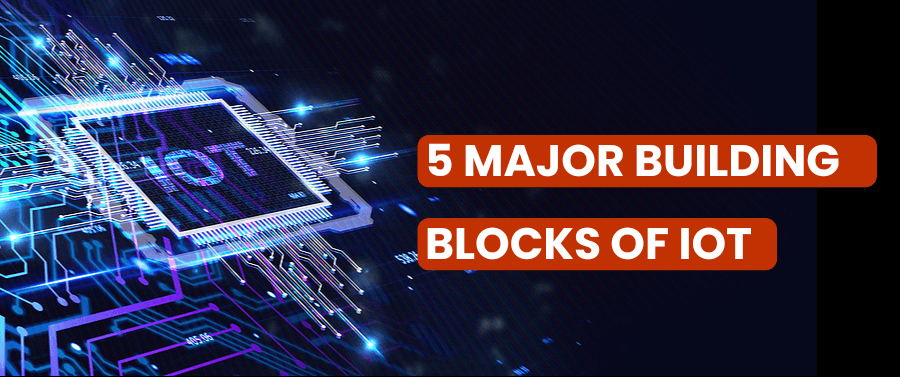5 Major Building Blocks of IoT (You Should Know)
Know the 5 major building blocks of IoT that form the foundation of its architecture and functionality. Now start with the first building block: - Sensors and Actuators

The IoT (Internet of Things) is a major technological invention of the 21st century that connects many everyday objects to the internet. You have already seen objects, like phones, refrigerators, and cars, that can communicate and share data with other devices. It opens up the possibilities of making these things communicate with each other and with us, making our lives easier and more linked.
With the help of IoT technology, we can manage our homes remotely, monitor our health with connected devices, as well as make our cities better. But what makes these devices work? What are the basic building blocks of IoT that make our lives easier? In this article, we will discuss the basic building blocks of IoT that enable devices to connect, collect data, and perform tasks intelligently.
1. Sensors and Actuators
Sensors and actuators are like the eyes and muscles of the IoT. Both of them play a foundational role in the creation of intelligent systems.
Sensors
Sensors are devices that are used to measure and quantify changes in the data from surroundings. Then it converts them into electrical signals. These signals can then be processed to give out helpful information about the surroundings.
Sensors collect data such as temperature, humidity, motion, light, etc. from the outside world. This data can be used for further analysis and decision making.
There are various kinds of sensors that focus on various aspects and collect different data. For example, temperature sensors can be used in a variety of applications, including household thermostats and engineered systems. Humidity sensors detect moisture levels in agriculture, health facilities, and any manufacturing industries. Motion sensors can be used in security systems, smart homes, and, for instance, in wearables. Some of the other available sensors include pressure sensors, light sensors, gas sensors, and air quality sensors.
Actuators
Where sensors collect data, actuators make use of that collected data to execute an action. In essence, they translate electrical impulses into mechanical movements. Actuators come in various forms, including:
- Electrical actuators - Motors, solenoids, and relays are types of electrical actuators. They use electrical energy to produce mechanical energy.
- Hydraulic actuators - They use fluids to apply force and get motion. It is most often used in construction equipment and heavy machinery.
- Pneumatic actuators - Uses compressed air as their power source. These actuators are common in industrial automation and robotics.
For example, a smart thermostat might turn on a heater or an air conditioner through inputs received from temperature sensors. In a manufacturing plant, a robotic arm could rotate based on the data gathered from proximity sensors.
2. Processors
The main strength of IoT devices lies in their ability to process information or data. In the computer world, the CPU is known as the brain of a computer. Same here; it is like the brain of the complete IoT system. Processors handle the data collected by sensors by processing it. IoT devices generate big amounts of data from sensors and actuators. These processors are responsible for processing this data efficiently, cleaning out the noise, and making it ready for further analysis or transfer. Additionally, processors allow encryption and decryption for ensuring data security.
Microcontrollers and Microprocessors
At the core of many IoT devices are microcontrollers or microprocessors. Even though the two terms are often used interchangeably, they do have different functions.
Microcontrollers in IoT are small integrated circuits that control electronic devices and systems. They have integrated processors and memories, as well as input/output devices on one chip. This makes them perfect for embedded applications where size, power efficiency, and real-time usage are critical. Microcontrollers are best suited for low-power devices such as sensors, actuators, and low-end controllers.
Microprocessors are CPUs that process data and instructions. These microprocessors may require peripheral devices to connect to memory, input/output devices, and other capabilities. It is best suitable for handling complex calculations. Ideally, they are used in IoT gateways that require higher processing requirements.
3. Network
The network serves as a nerve of the IoT system. It makes it easy for IoT devices to share and communicate data. Knowledge of the communication protocols, network topologies, and challenges is essential when engineering secure and efficient IoT systems.
Communication protocols define the rules for exchanging data between devices. The selection of protocols depends on range, data rate, power consumption, and security requirements.
Short-range protocols:
- Wi-Fi:It offers high data rates and is often used for home and office networks.
- Bluetooth: This is low-power, short-range connectivity medium. Better to use in wearables and smart home accessories.
- Zigbee:Optimized for low-power mesh networking, ideal for home automation and industrial applications.
- Z-Wave: Similar to Zigbee, but with a focus on home automation.
Long-range protocols:
- LoRaWAN: Low-power wide-area network (LPWAN) technology for long-range, low-data-rate applications.
- Sigfox: Another LPWAN technology with similar characteristics to LoRaWAN.
- Cellular: Offers wide coverage but typically consumes more power.
Choosing the Right Protocol
Selecting the appropriate communication protocol is essential for IoT success. Key considerations include:
- Range: How far do devices need to communicate?
- Data rate: How much data has to be sent?
- Power consumption:For how many hours should the battery last?
- Latency: At what rate data must be transmitted?
- Security: What level of protection is required?
- Cost: What is the budget for hardware and network infrastructure?
For instance, a smart home might use Wi-Fi for high bandwidth applications like smart televisions and Zigbee for low energy devices such as sensors and motors. A massive industrial IoT system might use cellular remote monitoring for asset tracking and LoRaWAN for sensors networks.
4. Gateway
Gateways play an important role as internediary devices that handle and process data coming from sensors. It usually has more processing and storage capacities than single IoT devices to complete various tasks necessary for the proper running of the IoT network.
Firstly, they are responsible for basic data analysis, which ensures that coming data is processed efficiently. Afterward, gateways transmit this information to various locations to efficiently use this data for performing more actions or storing it in centralized systems.
Functions of an IoT Gateway
IoT gateways play a pivotal role in IoT systems, performing several critical functions:
- Data aggregation: Gateways collect data from several IoT devices, and transform it into small packets able for transfer. This minimizes the congestion on the network and hence enhances efficiency.
- Protocol translation: IoT devices often use different communication protocols. Gateways make data translation, thereby transforming information from one format in different protocols to another.
- Security: Gateways are the initial entry points of the threats since hackers target them first. They follow practices of security technologies like encryption, authentication, and regulating user access to the data.
- Edge computing: Some gateways are capable of performing relatively simple data manipulation and analysis locally. It reduces latency and bandwidth consumption. This is known as edge computing.
5. Applications
The applications part is where the main goal of IoT is realized.
In this building block, the data that we collected and processed previously is now used to get some meaningful information. It is a user facing part of an IoT system. It is the interface between the above-mentioned (sensors, actuators, networks, processors) and the end-user. Here, a user gets useful insights about data that can be used in decision-making.
Examples of applications are smart home applications, healthcare/fitness device apps, logistics tracking applications, etc.
Let's take an example of fitness IoT device: Accelerometers and heart rate monitors (sensors) collect data about movement and bodily metrics. This data is transmitted through Bluetooth (network) to a smartphone (gateway) to perform simple functions such as the steps taken or calories burned (processors). This information is then displayed in the smartphone app (applications), where fitness goals are also set.
Thereafter, you can get valuable insights like sleep patterns or workout summaries based on the collected data. This process is similarly applied to other devices across various IoT use cases.
Future of IoT
The IoT world is constantly changing, and demand for innovative solutions is increasing at a fast speed. But we can definitely say that the future of IoT has great possibilities for shaping industries. Let's take a look:
- AI and Machine Learning: AI makes it easy for devices to learn from data, make intelligent decisions, and change themselves to dynamic conditions. AI-powered IoT apps enable you to manage energy usage, foresee equipment breakdowns, and improve clients’ interactions.
- Blockchain: It provides security, transparency, and building trust in the IoT networks and systems. Some of the uses are for data validation, supply chain management, and secure device authentication.
- 5G: The fifth generation of wireless technology is improving IoT connectivity by providing higher speeds, lower latency, and greater capacity. It also helps in utilizing the power of IoT applications in areas like autonomous vehicles, remote tasks, remote surgery, and industrial automation.
Conclusion
IoT is just not a collection of different devices, it's an ecosystem of interconnected components working in harmony. The process begins with gathering the unprocessed data that is gathered from sensors and continues to provide useful information that aids in decision making for the user. In this complete process, each building block of IoT plays an important role.
If you are interested in finding out more about how our IoT application development can be used to innovate and improve your business operations, please contact us today. We have a dedicated team of experts ready to tailor solutions to your specific needs and goals. Let's connect with us.
